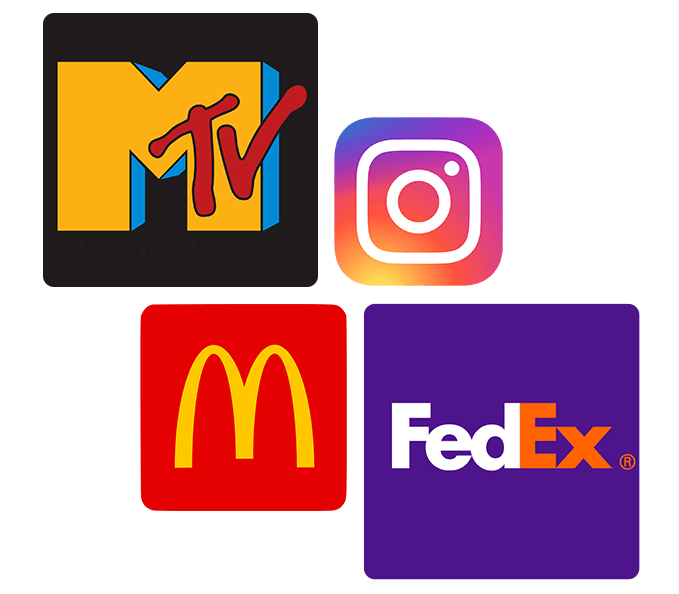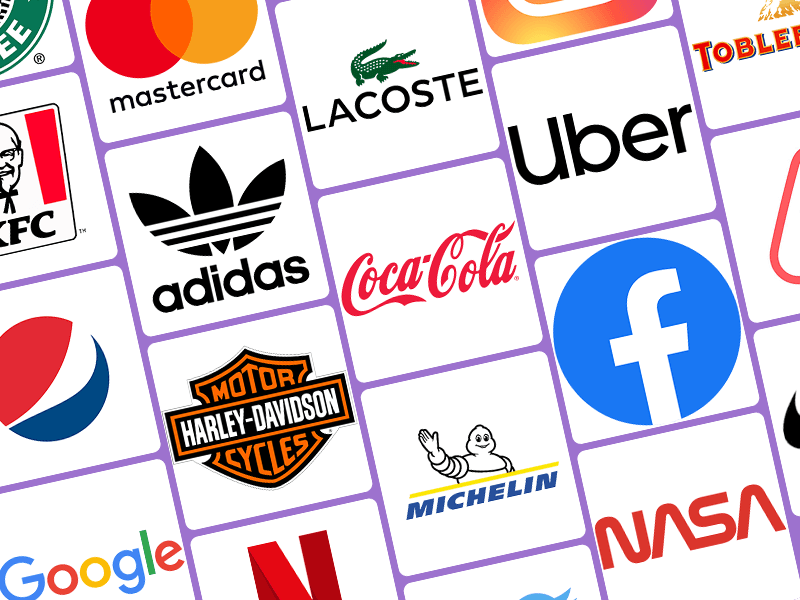
On a regular day, you come into contact with such a huge number of logos that you probably don’t even notice them anymore. However, not all of these logos have the same impact. There are reasons why the most famous logos in the world have reached their level of recognition.
What are some of the most famous brand logos, and what makes them stand out so much? We have the answers to these questions and more, so keep reading to get inspired!
Learn More About:
- What Is a Logo?
- Most Famous Logos By Type
- Characteristics of Famous Logos and What You Can Learn from Them
- Final Thoughts
What Is a Logo?
Many people confuse their brand with their logo, but your logo is only one portion of it. It is, however, an important part of your brand because your logo is a visual representation of your brand.
In general terms, your logo is a symbol that combines different elements to create a unique brand identity. It has to communicate what your brand stands for, what industry you’re in, and your values, and be unique enough to differentiate your brand from another.
While it’s common for logos to include text, a visual symbol, a distinct color palette, and even a tagline, a logo doesn’t necessarily have to include these elements. There are different types of logo designs you can choose from, like a text-based design, a symbol, or a combination of the two.
Using the right typography, color palette, graphic, and design will make your logo memorable, helping your brand stand out from the competition.
☝️ Not sure what colors to use when designing your logo? Use this logo color scheme guide to get your logo’s color palette just right!
Most Famous Logos By Type
Stop for a second or two and think of what you would consider some of the best logos of all time. What do they look like?
It’s very likely that they all look quite different. Some may be just text, like the Coca-Cola logo, while some may be just an icon, like the Apple logo.
Although these logos fit in the popular category, it doesn’t mean they look similar. They may use similar design principles, like the golden ratio, but there’s more to it. In fact, there are eight types of logos, and you will definitely be able to think of a famous logo (or many) that fits in these very different logo categories.
Wordmark or Logotype
As its name suggests, a wordmark is a logo that consists of just the company’s name. This sounds simple, but it can be tough to get it just right.
Famous wordmarks often use a custom typeface created specifically for the brand, making it unique. The unique typeface and a catchy brand name will help this sort of logo stand out.
Some of the most famous wordmarks include:
💡 Learn how to choose the best logo font for a stand-out logo design!
Lettermark or Monogram Logo
Like a wordmark, a letter mark or monogram is a typography-based logo. This type of logo is made up of the brand’s abbreviated name or its initials.
These types of logos will often use custom typefaces, but this isn’t a must. Brands can also use a typeface that represents their brand well and stands out in their overall design.
Some memorable monogram logos include:
Letterform Logo
Again, letterform logos rely on their typography to stand out. These are even shorter than a monogram and only feature a single letter that represents the brand’s name.
Since this type of logo is so reduced, it often works best for brands that are already well-known and easily recognizable.
Oftentimes, brands will have an established wordmark and then adapt that into a letterform once they have made their mark in their industry.
Some recognizable letterform logos include:
😊💡✨ Looking for design inspiration? Check out our logo ideas guide! It’s packed with design tips regarding graphic style, colors, and fonts and over 30 ideas sorted into 9 styles to perfectly match your vision.
Emblem Logo
Unlike the previous types of logos, an emblem uses a combination of text and images. They have a more traditional feel and are similar to crests.
Emblems are popular options for sports teams, schools, and more traditional brands. They tend to be more complex in design and can include several elements and smaller details.
Popular emblem logo designs include:
Pictorial Mark Logo or Brandmark Logo
A pictorial mark gets rid of all the text and relies on a symbol or graphic to represent a brand. The only rule here is that the graphic used in the logo has to be a real item.
These can also be tough to create since you are picking one single item to represent a brand. This can be easier to achieve success with if your brand’s name is something that mentions a real-life item, like Apple.
The key is to pick something timeless that doesn’t limit the brand’s image too much.
Famous brandmarks include:
Abstract Logo Design
An abstract logo may sound very similar to a pictorial mark because both are basically an image or graphic. What sets them apart is that an abstract logo uses a custom graphic made for the brand at hand.
An abstract logo won’t feature real-world items but rather a graphic unique to the brand. This makes it easier to pick something unique to your brand that will stand out in your niche.
Well-known abstract logos include:
Mascot Logo
A mascot logo is pretty straightforward: it’s a logo design that features an illustrated character. These can be based on a real or made-up person, animal, or any other type of character.
Oftentimes, mascot logos are good options for fun and playful brands since the mascot gives the logo a more whimsical look. Mascots are great for brands that target a younger audience since the mascot can be animated and used in ads and other marketing materials.
Some famous mascot logos include:
💡 Don’t forget to check out our animated logos!
Combination Mark Logo
A combination mark is comprised of a combination of a graphic and text. The text can be a whole word, a monogram, or even a single letter, but it has to be combined with a graphic to create this type of logo.
This type of logo is super common because it allows brands to use multiple elements that can turn into identifiers for their brand. You can take the different elements in this type of logo and split them up into logo variations for different uses.
A combination mark is a great starting point if your brand is new.
Some recognizable combination mark logos include:
💡 Psssst, do you want to know what types of logos work best for your business? Then, find it out by taking this quick quiz!
Characteristics of Famous Logos and What You Can Learn from Them
Now that you’ve looked at some of the most well-known logos across the world, you may be wondering what they have in common. While they may not look similar or follow similar aesthetics, there are some fundamental design rules they all follow. Keep these six important tips in mind when learning how to design a logo.
- Simplicity: When designing a logo, simplicity is key for several reasons. A logo that is simple and to the point will be more impactful and memorable. Another important reason to keep it simple is for branding purposes. A simple logo will be easier to reproduce in all sizes, colors, and black and white.
- Relevance: You want your logo to make sense for the industry your brand is a part of. The color palette, graphics, brand name, and typography should help your logo clearly relay what you sell or do and what your brand stands for.
- Memorable: A logo is doing its job when it represents what your brand is all about and when it is memorable and recognizable. Simple design, unique typography, or a bold color palette can be enough to ensure your logo sticks out in people’s minds.
- Timeless: A trendy logo may seem like a good option, but remember that trend cycles move fast. Rebranding every time trends change will ensure your brand is forgotten, so instead, opt for something timeless that is true to your brand. You can always make small updates to your logo that don’t change it too much, but the idea is to remain constant and recognizable.
- Versatile: This goes along with the point on simplicity. Since logos are used on tiny items like a favicon or a business card and on large items like billboards and banners, they have to look good in all of these sizes. Avoid too many details that will get lost and just look jumbled as a logo is resized.
- Smart: Smart design may sound vague, but it’s crucial when designing a logo. Since you can’t use tiny details, you’ll have to think smart to get your message across. Edit down the details, use simple shapes, stick to bold color combos, and remember that negative space is your friend. Remember that a clever design will stick with people and get them talking, so go clever.
⚡️ If you’re currently working on your brand’s logo, avoid these 10 characteristics of bad logo design.
Final Thoughts
Not all logos are made equally, and it’s clear now why some of them are more memorable and iconic. A great design doesn’t mean your brand will automatically be successful, but it can help. Learn what you can from the logos you love, and apply this knowledge when creating your own brand’s logo. Don’t forget to read our guide that talks about the best logo markers in the market to create your next big brand asset.
Check out our ultimate guide to logo design to learn everything from what a brand is to how to trademark your logo.
Let us know in the comments below what other popular logos you love ⤵️
